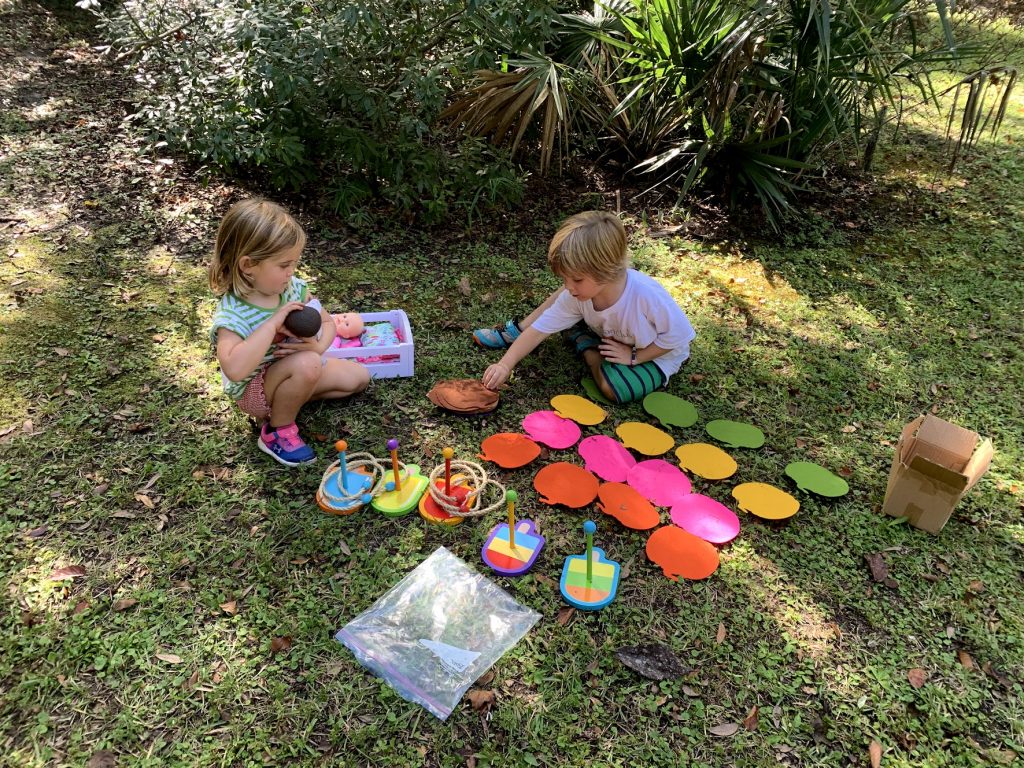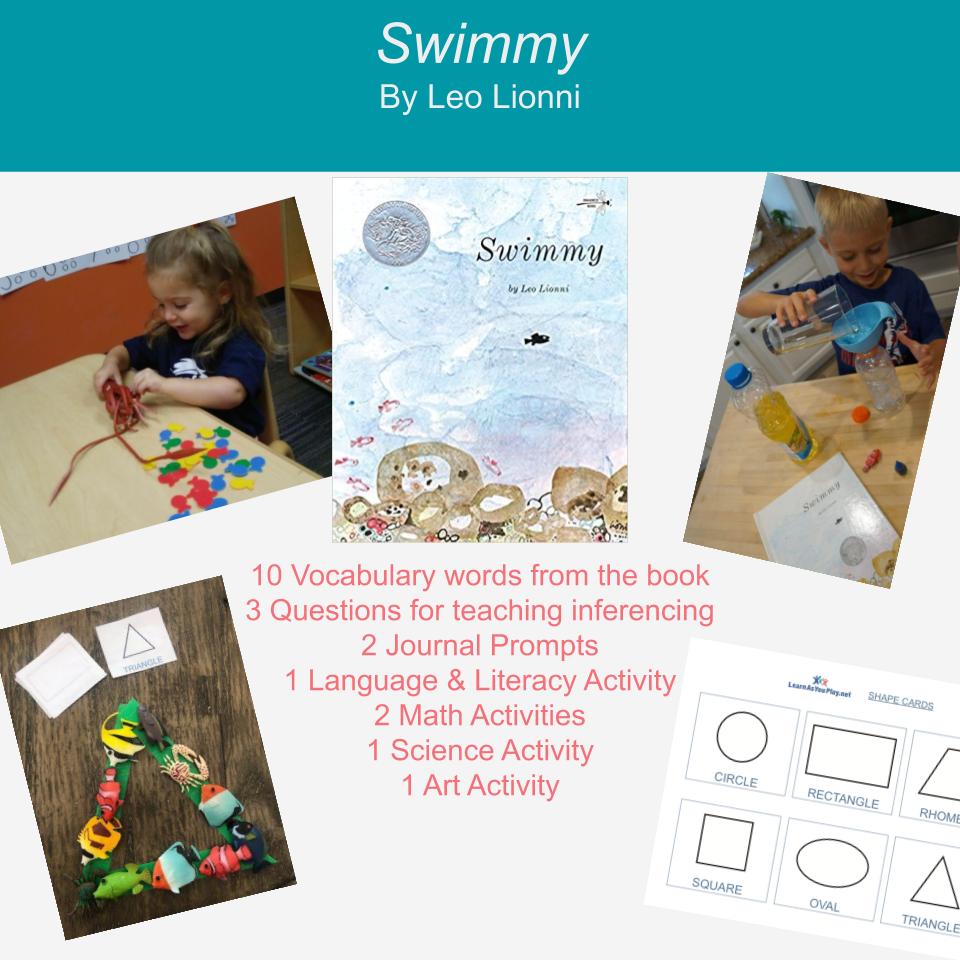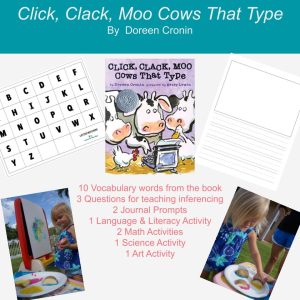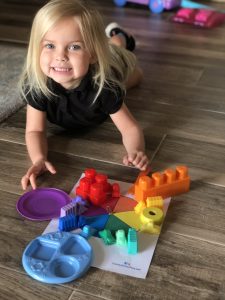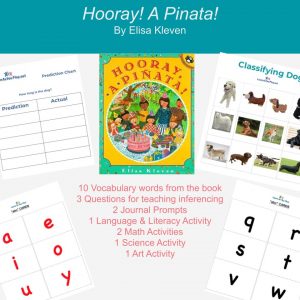First published in Home and Classroom magazine, Vol. 5, 2021
Written by Debbie Markland, December 2020
I love the outdoors.
My own children, now ages 17, 20, and 22, spent much of their childhood outdoors – running around in the woods in our backyard, playing in the creek, getting muddy, enjoying parks, finding new hiking trails, and exploring open spaces in our local community. I was not really aware at the time of all the benefits of children being outdoors until I became an early childhood educator, and working at a school with a very large outdoor natural space. I began to embrace the outdoors even more as I learned about inquiry based curriculum, emerging curriculum and the project approach. The outdoor space I had at my former school was a large natural playground with trees to climb, sand to dig in, a mud kitchen to cook in, loose parts to move around and create with, water to pump and study, a garden to nurture, and bumpy terrain to navigate. It truly was amazing!
As I spent hours, yes hours, outside with children everyday, I began to understand and appreciate the learning that takes place while being outdoors. I have since left that school, and now teach at a smaller school, where there is a more traditional smaller playground. As COVID altered our lifestyles, I knew I wanted to be outside with my new class as much as possible. I had to alter my thinking to determine what this would look like within the parameters of the school’s property.

This is what I want to share with you – while not all preschools may have an intentionally designed outdoor learning space, taking learning outside is doable wherever you are. COVID has taught me and the two other teachers, Tirion and Haley Sheafor, in this article just this – by simply looking at your given school’s space with an outdoor learning eye, by thinking of the outdoors as equally as important as any other learning space, you can take learning outdoors! Here is how we did it!


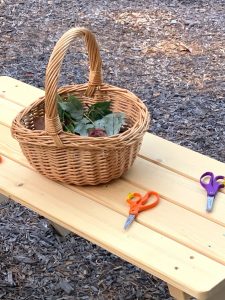

I teach at a half-day church preschool in Dunwoody, GA – Saint Luke’s Little Saints (part of Saint Luke’s Presbyterian Church). I teach Three Day Threes, and I have 6 children enrolled in my class. My nieces, Tirion and Haley Sheafor, teach at a half-day church preschool, Providence Church Preschool, in Daniel Island, SC. They teach Two Day Threes, and they have 7 children in their class. As the three of us started discussing how we were going to teach during COVID, we realized that we were on the same page – we wanted to continue to teach in a developmentally appropriate manner while being outside as much as possible. While as a group we knew we loved being outdoors and we knew learning often naturally took place outdoors, we had to intentionally think about how we would create a plan for outdoor learning places, and present the plan and the benefits to administration and to families.
We knew that the CDC had determined that coronavirus dispersed more quickly outside than inside, and we knew that taking learning outdoors was done in the early 20th century to combat Tuberculosis. So in addition to the many benefits of simply playing outside – it simply was a safer, healthier choice as the Coronavirus cases continued to be present and growing in our communities. Both administrators agreed with us, and we moved forward. Our administrators were so supportive, that our ideas were shared with the entire staff at our respective. I, in fact, did a mini-presentation for our staff that you can find here: https://youtu.be/1TUoDldF_-o

My school, Saint Luke’s Little Saints Preschool, in Dunwoody, GA sits on the corner on a fairly busy street and has neighborhoods on both sides. There is not much natural area on the church property, but plenty of parking lot space, and two traditional playgrounds – one designed for 2 year olds and younger, and one designed for 3 year olds and up. As I started to look at the property with my outdoor learning eye, I shifted my thinking to look at the property for two things – where could I set up a defined, more permanent outdoor classroom, and what places and areas could we walk to and explore on the property.
My assistant had the idea to simply use the small playground as our outdoor space. Typically this space is the two year old playground, but they have not started yet, so we have claimed it as ours for now. In this space, I have 2 child size picnic tables, an easel, and a homemade, collapsible 4 feet by 4 feet square table (I used 5 gallon buckets as the base and a piece of wood). In the morning when I arrive at work, I set up this space just like I would my classroom. I have a blanket on the ground with books for their reading center. I have an easel ready with paper and paint, markers or do-a-dot markers. I bring out some type of block for the day to use at the square table. At one of the small picnic tables, I have some sort of fine motor provocation – last week we cut leaves, and the week before we hammered golf tees into pumpkins. At the other table, I have dry erase boards and markers. These are just a few examples. Really the options are endless. Next week, I plan on putting giant white paper on the wall and painting with pine needles! We start our day in this space (the “third teacher) and my assistant and myself rotate through the different areas observing learning and looking for teachable moments.




In addition to our class outdoor space, we also use other parts of the church property. We might find a shaded spot, set up a blanket and have our snack somewhere, and maybe even do an art project. We sometimes look for steps to sit on for storytime. We find some open spaces for sidewalk chalk. We go on lots of walks – we look for sticks, leaves, pinecones, or acorns to collect which we bring back to our class and use as in a math exploration or in an art project. I was thrilled to recently observe 4 of my 3 year old buddies using acorns we had collected to play “family” – baby acorns, mommy acorns, daddy acorns. Our church has numbered parking spots – one day we went on a numeral hunt. I loved when one of my little friends said, “Wow- we are going to look for real numbers?”

Providence Church Preschool, on Daniel Island, SC also sits on a corner, the building is a little smaller, but this provides Tirion and Haley’s class with lots of outdoor spaces to utilize. They have established one space as “theirs” as well. They spend most of their day in this space, but also explore other areas. Instead of using picnic tables, each student has their own plastic lap desk. Using these has worked out well- they are used for journals, art projects, playdough, and more.

Tirion and Haley had started to introduce the idea of embracing the outdoors when they started working at Providence three years ago. At the time, other than “playing on the playground,” there was not much true outdoor learning. One of the outdoor enhancements they made was adding tree stumps to the playground – this has been one of the favorite activities for the children this year. What great gross motor and body awareness fun – I can imagine too that some great math lessons naturally occur while jumping on the stumps! Also adding to their space, they have gardening! They have started seedlings in egg shells and then transferred them to their “bucket garden” on the fence.
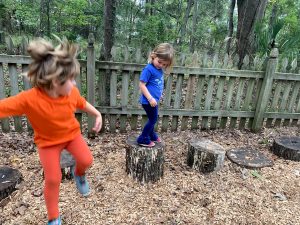

One of the recent highlights of Tirion and Haley’s class “campus” walks was discovering a clump of mushrooms. They visit it daily and have given that outdoor space the appropriate name, “the mushroom room.” I love this as it shows the children do see their outdoor class spaces no differently than their indoor class spaces.
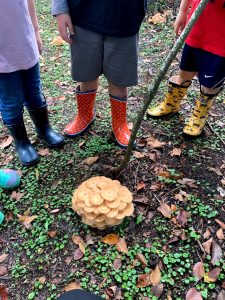
This three year old class on Daniel Island, also brings some things from inside to their outdoor space. They have brought an easel for art, and tweezers and tongs for fine motor work. Continuing to embrace nature and being outside, they tend to use these with natural items. Instead of using their tweezers to pick up plastic beads, they’ll find acorns and leaves and sticks. Instead of using unit blocks or Legos, children build with pumpkins, sticks, and stones. Tirion shared with me, “We have learned to take a more minimalist approach. The kids have been learning and creating on their own with what is around them in nature. They are learning the whole time they are in our outdoor classroom.”
Tirion and Haley’s class spends the whole morning outside – the only time they go indoors is for bathroom breaks. Their director purchased them an outdoor sink and they keep their bookbags on a coat rack. They have made simple small adjustments and it has been a huge success. Haley shared, “It was not what the children were used to, but they have adapted well. Their classroom isn’t set by four walls.”
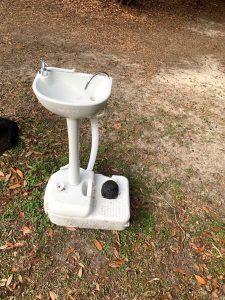

Both classes have experienced rainy days. The idea of rain was a concern from some parents and teachers when the idea of outdoor learning was introduced. Rain boots and rain jackets are utilized and children always have a change of clothes. One of my favorite ideas I came across while continually educating myself about outdoor learning is – I have never met a child that couldn’t get dry again. So true! In fact one of my favorite adventures around our school’s property was puddle hunting. We looked at our reflections in the puddles and then enjoyed the fun of splashing and jumping into the puddles. They loved it. Yes, they got wet, and were super excited to jump in their cars at pickup and say excitedly – “Guess what Mom? We jumped in puddles!”
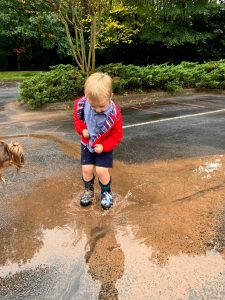
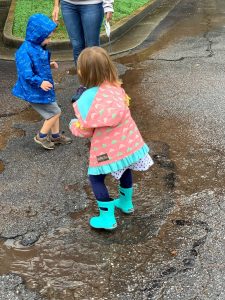
So far, two months into the COVID 2020 school year, we all feel like our shift to embracing the outdoors has been a success. Our children (and us!) have remained healthy for one, and we have learned how to just look at things differently. We are not teachers in an endorsed Forest School, nor are we teachers in a school with a large outdoor plot of land that was purposefully designed for outdoor learning, but as the three of us continue to research outdoor education, we have become confident that everything that we once did indoors, can be taken outdoors. And, not only can it be done, but it seems to be easier than we thought to come to fruition, and most importantly the children are happy, learning and healthy.
Author Bio:
Debbie Markland teaches three year olds in Dunwoody, GA at Saint Luke’s Little Saints Preschool. She also helps with LearnAsYouPlay, an early education blog that believes play is essential to childhood, and is the root of all learning. She is married, has three grown children and lives in Roswell, GA. In this article she also consulted Tirion Sheafor and Haley Sheafor, her twin nieces who teach a three year old classroom at Providence Church Preschool in Daniel Island, SC.

